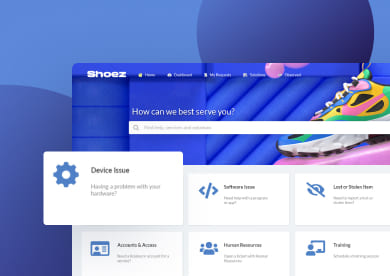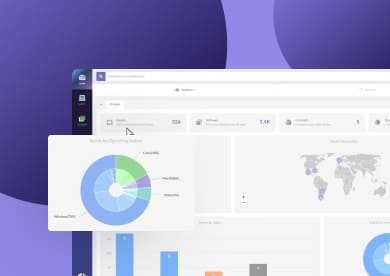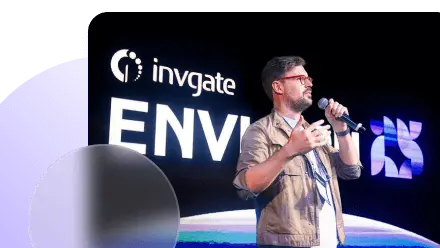IT hardware procurement is the practice of sourcing, purchasing, and managing the devices and equipment that keep an organization running. It’s a critical function in every company, but it’s especially important in IT, where hardware accounts for some of the highest-ticket spending.
The problem? Not every organization has a well-defined process. In fact, 68% of businesses admit they either have no procurement process at all or only an informal one (Ramp). That lack of structure leads to overspending, inefficiencies, and poor visibility into where the money goes.
In this blogpost, we’ll define what IT hardware procurement really means and outline a simple yet effective process you can follow to get it right.
What is IT hardware procurement?
IT hardware procurement is the process of purchasing the physical equipment an organization needs to operate its technology environment. This includes laptops, desktops, servers, monitors, networking devices, and other essential components that keep employees productive and systems running smoothly.
Put simply, it’s about making sure the right hardware is bought at the right time, from the right vendors, and at the right price. A clear procurement process helps companies control costs, standardize equipment, and avoid the risks of ad-hoc or unmanaged purchases.
Why is hardware procurement important?
Procurement is important in every business, but IT hardware procurement stands out because it involves high-ticket purchases that directly impact budgets, productivity, and scalability.
It also carries added risks. Poor decisions or unmanaged buying can create hidden costs, compliance issues, and even security risks of hardware procurement if devices aren’t standardized or properly tracked.
Benefits of IT hardware procurement
- Cost control: A well-structured hardware procurement process helps standardize purchases, prevent overspending, and secure better vendor discounts.
- Operational efficiency: Streamlined hardware procurement & setup ensures employees get the right devices on time, avoiding downtime.
- Asset Lifecycle Management: Supports a clear hardware lifecycle procurement plan, extending device longevity and maximizing ROI.
- Risk reduction: Minimizes compliance issues and the security risks of hardware procurement by keeping purchases visible and controlled.
- Better vendor relationships: Centralized IT hardware procurement solutions improve negotiations and vendor support while reducing complexity.
Challenges of IT hardware procurement
- High costs: One of the biggest high-ticket expenses in IT is computer hardware procurement, since laptops, servers, and networking devices require large upfront investments that can strain budgets.
- Vendor complexity: Managing multiple contracts across hardware and software procurement can be overwhelming without the right tools.
- Rapid obsolescence: Devices lose value quickly, making it hard to align endpoint hardware procurement with long-term business needs.
- Process gaps: Many companies lack an IT hardware procurement policy, leading to inefficiencies, rogue spending, and missed savings.
- Compliance pressure: Without efficient hardware procurement methods, untracked devices introduce audit failures, data protection issues, and other risks.
Types of hardware procurement
When we talk about hardware procurement meaning, it can cover many areas in a company, from factory machinery to office equipment. But here we’ll focus on IT hardware procurement, since it’s one of the most critical and high-ticket types.
Within IT, there are several subtypes of hardware procurement, each with its own priorities and risks. Breaking them down helps organizations design a clear hardware procurement roadmap and apply more efficient hardware procurement methods.
- Computer hardware procurement – Desktops, laptops, and peripherals employees use daily.
- Server and data center procurement – Infrastructure like servers, storage, and networking gear.
- Endpoint hardware procurement – Mobile devices, tablets, and other distributed hardware.
- Hardware and software procurement – Bundled purchasing of devices with the software they require.
- Lifecycle procurement – Purchases based on refresh cycles, warranties, or asset age.
- Ad-hoc vs. strategic procurement – Reactive buying versus structured processes defined by an IT hardware procurement policy.
The IT hardware procurement process
A structured hardware procurement process ensures consistency, accountability, and cost control. Here’s a simple roadmap tailored to IT:
Step 1: Assess organizational needs
Begin by identifying your IT hardware requirements. This includes laptops for new hires, servers for infrastructure, or endpoint devices for remote workers. Consider operational costs, scalability, compatibility with existing systems, and upcoming projects. Evaluating your current inventory will help spot gaps and avoid duplicate purchases.
Step 2: Establish procurement policies
Define clear IT hardware procurement policies to guide decisions. These should include budget limits, preferred IT vendor lists, approval workflows, and record-keeping requirements. Having policies in place prevents rogue purchases, ensures accountability, and supports compliance during audits.
Step 3: Research vendors and products
Vendor selection is critical in computer hardware procurement. Review supplier reputation, product specifications, warranty options, and after-sales support. Always check for compatibility with your existing environment and prioritize vendors with proven reliability in IT hardware delivery.
Step 4: Request and review quotes
Issue Requests for Proposals (RFPs) or Quotes (RFQs) to shortlisted vendors. Compare pricing, delivery timelines, discounts, and service agreements. An organized evaluation ensures cost-effective purchases without compromising quality.
Step 5: Make the purchase
Once a vendor is chosen, generate purchase orders, confirm payment schedules, and document all agreements. This step is where you formally procure hardware, so accuracy and transparency are key to avoiding budget overruns.
Step 6: Receive and inspect hardware
When the hardware arrives, inspect it carefully to confirm it matches agreed specifications. This step is especially important in endpoint hardware procurement, where device configuration and security standards must be checked before deployment.
Step 7: Deploy and document
Finally, deploy the new assets into your IT environment. Document configuration details, assigned users or departments, and maintenance schedules. Proper documentation supports hardware lifecycle procurement, enabling better tracking, budgeting, and security management in the long run.
Using InvGate Asset Management as your hardware procurement solution

A well-structured IT hardware procurement process is easier to execute when supported by the right tools. This is where InvGate Asset Management comes in. From the moment new devices arrive until they are fully deployed, it provides visibility, automation, and control across the entire procurement lifecycle.
Here’s how InvGate shines in this area:
- Centralized inventory – As soon as assets are received, they can be logged automatically, with specifications, warranty details, and configurations captured in one place.
- Stock monitoring and reordering – Track available hardware in real time and trigger reorders (for example, when monitors or laptops run low at a specific location).
- Procurement workflows – Standardize requests, approvals, and vendor communication with customizable workflows. InvGate integrates with many ITSM tools, including InvGate Service Management, to connect procurement with service delivery.
- Bulk data uploads and automation – Import vendor spreadsheets to register multiple assets quickly. Much of this can also be automated with the InvGate Agent, network discovery, and native integrations, reducing manual effort and ensuring a complete IT asset inventory.
- QR code generation – Create and assign QR codes for each device, making it easy to identify, track, and update asset records throughout their lifecycle.
- Lifecycle visibility – From “in stock” to active deployment, each asset’s history, compliance, and service status are fully traceable.
By combining these features, InvGate Asset Management helps IT teams move from a reactive to a proactive approach, ensuring efficient hardware procurement methods and seamless integration into the broader asset lifecycle.
Ready to optimize your IT hardware procurement? Start today with a 30-day free trial or talk to our team to explore how InvGate Asset Management can transform your procurement process.
Best practices for the hardware procurement process
To make smart, sustainable hardware purchases, your procurement strategy should be aligned with your business goals, operational needs, and compliance requirements. Below are some key best practices to guide the process and avoid costly mistakes.
#1: Establish a clear procurement strategy
Start by setting standardized guidelines for how hardware should be purchased across the organization. This includes defining who’s responsible for procurement, outlining approval workflows, and setting policies for vendor selection and budget allocation.
#2: Evaluate TCO and ROI
Don't just look at the price tag. Consider the long-term costs of maintaining, supporting, and eventually replacing the asset.
Estimating Total Cost of Ownership (TCO) and Return On Investment (ROI) helps justify your investment and prevents unexpected expenses down the line.
#3: Research vendors and products thoroughly
Take time to vet suppliers. Look at reviews, compare product specs, evaluate support options, and check compatibility with your current environment. Prioritize vendors with strong customer service, timely delivery, and flexible terms.
#4: Implement cost control measures
Bulk purchasing, long-term contracts, and strategic vendor negotiations can all drive down costs. Make sure to monitor procurement expenses regularly to identify potential savings opportunities.
#5: Prioritize security and vendor management
Choose hardware with built-in security features and stay on top of vendor updates and patches. A strong vendor management strategy ensures your hardware stays supported and protected over time.
#6: Stay compliant with regulations and standards
From data protection laws to industry-specific requirements, compliance should be built into your procurement process. This minimizes risk and helps maintain audit readiness.















